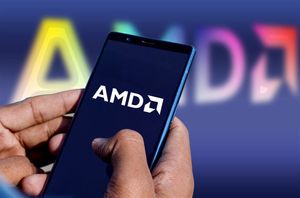
As the digital frontier continues its relentless expansion, the convergence of quantum computing, artificial intelligence (AI), and advanced semiconductors is rapidly redefining the technological landscape. Far from speculative hype, a robust investment ecosystem is emerging, driven by foundational technological breakthroughs and long-term value creation. This intricate interplay promises to unlock unprecedented computational power, demanding a strategic approach from investors looking to capitalize on the next wave of innovation. The current date of October 8, 2025, places us at a pivotal moment where early applications are demonstrating tangible value, setting the stage for transformative impacts in the coming decades.
The investment landscape for both quantum computing and AI semiconductors is characterized by significant capital inflows from venture capital, corporate giants, and government initiatives. Publicly announced investments in quantum computing alone reached $1.6 billion in 2024, with the first quarter of 2025 seeing over $1.25 billion raised by quantum computer companies, marking a 128% year-over-year increase. Total equity funding for quantum technologies reached $3.77 billion by September 2025. Similarly, the global semiconductor market is increasingly dominated by AI, with projections for an 11% boost to $697.1 billion in 2025, largely fueled by surging demand from data centers and hyperscale cloud providers. This confluence represents not just incremental upgrades, but a fundamental shift towards a new generation of intelligent systems, demanding a clear-eyed investment strategy focused on enduring value.
The Technical Crucible: Advancements at the Quantum-AI-Semiconductor Nexus
The rapid pace of technological advancement is a defining characteristic of this tri-sector intersection. In quantum computing, qubit counts have been doubling every 1-2 years since 2018, leading to improved coherence times and more reliable error correction schemes. Systems boasting over 100 qubits are beginning to demonstrate practical value, with silicon-based qubits gaining significant traction due to their compatibility with existing transistor manufacturing techniques, promising scalability. Companies like Intel (NASDAQ: INTC) are making substantial bets on silicon-based quantum chips with projects such as "Horse Ridge" (integrated control chips) and "Tunnel Falls" (advanced silicon spin qubit chips).
Concurrently, AI semiconductors are experiencing a revolution driven by the need for specialized hardware to power increasingly complex AI models. Nvidia (NASDAQ: NVDA) maintains a dominant position, holding an estimated 80% market share in GPUs used for AI training and deployment, with recent launches like the Rubin CPX GPU and Blackwell Ultra Platform setting new benchmarks for inference speed and accuracy. However, the evolving AI landscape is also creating new demand for specialized AI processors (ASICs) and custom silicon, benefiting a wider range of semiconductor players. Innovations such as photonic processors and the increasing use of synthetic data are redefining efficiency and scalability in AI ecosystems.
Crucially, AI is not just a consumer of advanced semiconductors; it's also a powerful tool for their design and the optimization of quantum systems. Machine learning models are being used to simulate quantum systems, aiding in the development of more effective quantum algorithms and designing smarter transpilers that efficiently translate complex quantum algorithms into operations compatible with specific quantum hardware. Australian researchers, for instance, have used quantum machine learning to more accurately model semiconductor properties, potentially transforming microchip design and manufacturing by outperforming classical AI in modeling complex processes like Ohmic contact resistance. Furthermore, Nvidia (NASDAQ: NVDA) is collaborating with Alphabet (NASDAQ: GOOGL)'s Google Quantum AI to accelerate the design of next-generation quantum computing devices using the NVIDIA CUDA-Q platform and the Eos supercomputer, enabling realistic simulations of devices with up to 40 qubits at a fraction of traditional cost and time. This synergy extends to quantum computing enhancing AI, particularly in accelerating machine learning tasks, improving natural language processing (NLP), and solving complex optimization problems intractable for classical computers. IonQ (NYSE: IONQ) has demonstrated quantum-enhanced applications for AI, including pioneering quantum generative modeling and using a quantum layer for fine-tuning Large Language Models (LLMs), yielding higher quality synthetic images with less data and projected significant energy savings for inference.
Corporate Chessboard: Beneficiaries and Competitive Implications
The strategic confluence of quantum computing, AI, and semiconductors is reshaping the competitive landscape, creating clear beneficiaries among established tech giants and innovative startups alike. Companies positioned at the forefront of this convergence stand to gain significant market positioning and strategic advantages.
Nvidia (NASDAQ: NVDA) remains a titan in AI semiconductors, with its GPUs being indispensable for AI training and inference. Its continued innovation, coupled with strategic investments like acquiring a $5 billion stake in Intel (NASDAQ: INTC) in September 2025, reinforces its market leadership. Hyperscale cloud providers such as Microsoft (NASDAQ: MSFT), Alphabet (NASDAQ: GOOGL) (Google Cloud), and Amazon (NASDAQ: AMZN) (AWS) are making massive investments in AI data centers and custom silicon, driving demand across the semiconductor industry. Microsoft, for example, plans to invest $80 billion in AI data centers. These companies are not just users but also developers, with IBM (NYSE: IBM) and Google Quantum AI leading in quantum hardware and software development. IBM and AMD are even teaming up to build "quantum-centric supercomputers."
Pure-play quantum companies like IonQ (NYSE: IONQ), Rigetti Computing (NASDAQ: RGTI), and D-Wave (NYSE: QBTS) are attracting substantial capital and are critical for advancing quantum hardware and software. Their ability to offer access to their quantum computers via major cloud platforms like AWS, Microsoft Azure, and Google Cloud Marketplace highlights the collaborative nature of the ecosystem. The demand for specialized AI processors (ASICs) and custom silicon also benefits a wider range of semiconductor players, including startups like Rebellions, which secured a $247 million Series C round in Q3 2025, demonstrating the vibrant innovation outside of traditional GPU giants. The "Sovereign AI" concept, where governments invest in domestic AI capabilities, further fuels this growth, ensuring a stable market for technology providers.
A Broader Canvas: Significance and Societal Impact
The integration of quantum computing, AI, and advanced semiconductors fits into a broader AI landscape characterized by accelerated innovation and increasing societal impact. This convergence is not merely about faster processing; it's about enabling entirely new paradigms of problem-solving and unlocking capabilities previously confined to science fiction. The quantum computing market alone is projected to reach $173 billion by 2040, generating an economic value of $450 billion to $850 billion globally, according to McKinsey, which projects the quantum market to reach $100 billion within a decade. The overall semiconductor market, bolstered by AI, is expected to grow by 11% to $697.1 billion in 2025.
The impacts are wide-ranging, from enhancing cybersecurity through post-quantum cryptography (PQC) embedded in semiconductors, to revolutionizing drug discovery and materials science through advanced simulations. AI-driven processes are projected to significantly reduce content production costs by 60% and boost conversion rates by 20% in the consumer sector by 2025. However, alongside these advancements, potential concerns include the technological immaturity of quantum computing, particularly in error correction and qubit scalability, as well as market uncertainty and intense competition. Geopolitical tensions, export controls, and persistent talent shortages also pose significant challenges, particularly for the semiconductor industry. This period can be compared to the early days of classical computing or the internet, where foundational technologies were being laid, promising exponential growth and societal transformation, but also presenting significant hurdles.
The Horizon Ahead: Future Developments and Challenges
Looking ahead, the near-term future (the "Noisy Intermediate-Scale Quantum" or NISQ era, expected until 2030) will see continued advancements in hybrid quantum-classical architectures, where quantum co-processors augment classical systems for specific, computationally intensive tasks. Improving qubit fidelity and coherence times, with semiconductor spin qubits already surpassing 99% fidelity for two-qubit gates, will be crucial. This era is projected to generate $100 million to $500 million annually, particularly in materials and chemicals simulations, alongside early use cases in optimization, simulation, and secure communications.
Longer-term developments (broad quantum advantage from 2030-2040, and full-scale fault tolerance after 2040) envision truly transformative impacts. This includes the development of "quantum-enhanced AI chips" and novel architectures that redefine computing, delivering exponential speed-ups for specific AI workloads. Quantum-influenced semiconductor design will lead to more sophisticated AI models capable of processing larger datasets and performing highly nuanced tasks. Potential applications and use cases on the horizon include highly optimized logistics and financial portfolios, accelerated drug discovery, and advanced cybersecurity solutions, including the widespread integration of post-quantum cryptography into semiconductors. Challenges that need to be addressed include overcoming the formidable hurdles of error correction and scalability in quantum systems, as well as addressing the critical workforce shortages in both the quantum and semiconductor industries. Experts predict a continued focus on software-hardware co-design and the expansion of edge AI, specialized AI processors, and the long-term potential of quantum AI chips as significant future market opportunities.
A Strategic Imperative: Navigating the Quantum-AI Semiconductor Wave
In summary, the convergence of quantum computing, AI, and advanced semiconductors represents a strategic imperative for investors looking beyond fleeting trends. The key takeaways are clear: robust investment is flowing into these areas, driven by significant technological breakthroughs and a growing synergy between these powerful computational paradigms. AI is not just benefiting from advanced chips but is also a critical tool for designing them and optimizing quantum systems, while quantum computing promises to supercharge AI capabilities.
This development holds immense significance in AI history, marking a transition from purely classical computation to a hybrid future where quantum principles augment and redefine what's possible. The long-term impact will be profound, touching every sector from finance and healthcare to manufacturing and cybersecurity, leading to unprecedented levels of efficiency, innovation, and problem-solving capabilities. Investors should watch for continued advancements in qubit fidelity and coherence, the maturation of hybrid quantum-classical applications, and the strategic partnerships between tech giants and specialized startups. The coming weeks and months will likely bring further announcements on quantum hardware milestones, new AI semiconductor designs, and early commercial deployments demonstrating the tangible value of this powerful technological triad.
This content is intended for informational purposes only and represents analysis of current AI developments.
TokenRing AI delivers enterprise-grade solutions for multi-agent AI workflow orchestration, AI-powered development tools, and seamless remote collaboration platforms. For more information, visit https://www.tokenring.ai/.






